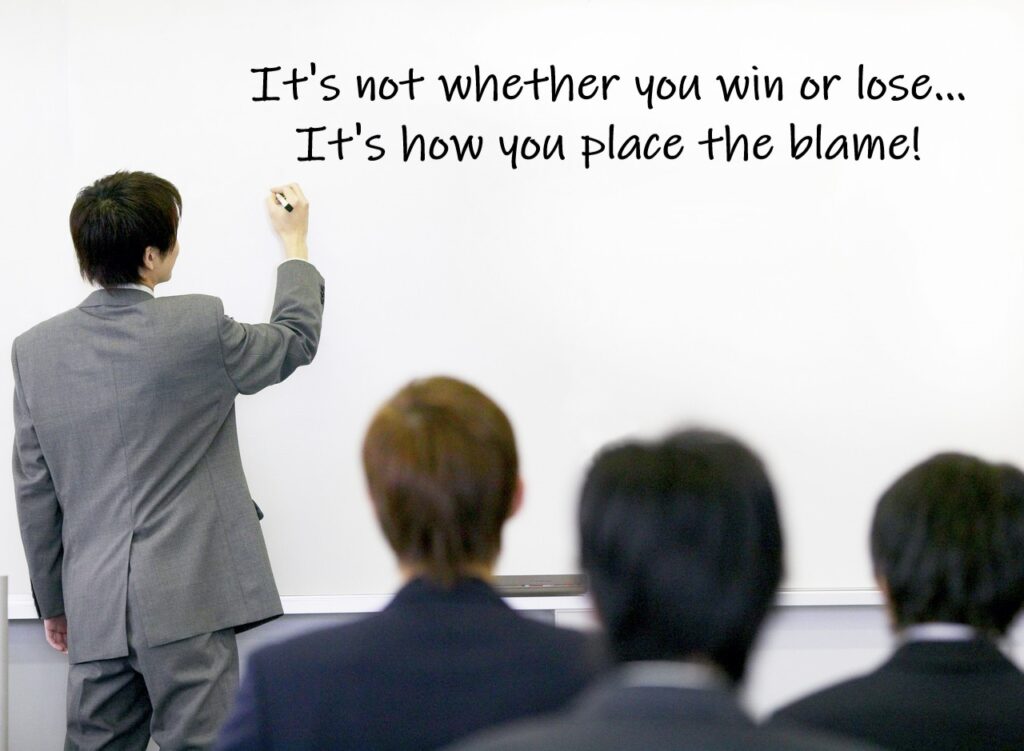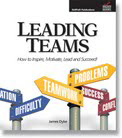Solve the customer’s problem FIRST…THEN worry about assigning BLAME.
This advice comes from one of my own clients.
Up Close and Personal
A few years ago, I was preparing for a management training seminar for one of my corporate clients. As part of the preparation, I interviewed my contact there, to get some valuable information about the group of managers attending, the organization, and the issues they wanted me to address.
I asked my contact one of my most important questions: “Is there any specific issue, problem, or need you want me to be sure to address?”
His answer was IMMEDIATE! He told me, “Will you PLEASE tell these managers: When there’s a problem with one of our customers…Solve the customer’s problem FIRST, THEN worry about who to blame for it!”

Why do we blame?
I suspect, for most of us, it’s an instinctive self-protective response in the heat of the moment. It probably starts in childhood, when we learn to point the finger at another sibling, playmate, or even a household pet! (“The dog ate my homework.”)
When it becomes a consistent pattern…it probably flows from a poor self-image and accompanying emotional insecurities. No matter what causes this kind of low self-esteem, it’s definitely best addressed by professional counseling or psychotherapy.
If it continues…it becomes an insidious form of victimhood.

The problem with victimhood is that it prevents any growth or change—it’s the perfect barrier to any kind of personal development. Civil rights activist Bob Woodson put it this way:
Nothing is more lethal than giving people a good excuse to fail.
One of the most important things I offer my executive coaching clients is the gift of empowerment. The primary goal in our sessions together is to identify actions that the coaching client can take to address the challenges they face. My purpose is to put my client in the “driver’s seat”—to give them the sense that they are “in charge” and not “at the mercy” of other people; situations; or circumstances. Empowerment is the ultimate antidote to victimhood.
Of course, I also help my client understand the realistic limits of their control! Without a healthy sense of boundaries, any of us can easily fall prey to our own arrogance and forget that we are not the only stars in the heavens. We can’t do everything ourselves. We need to learn to collaborate. Which brings us to the next point…
Who do we blame?

1. The other guy. The nearest target is often someone on our own team—a colleague we can conveniently scapegoat (“It was Bob’s job to get the numbers right and he blew it!”). It’s even worse when we blame our own direct reports (“I’ve got idiots working for me”). When other people hear an excuse like that, their first thought about this boss is, “Maybe YOU are a bigger idiot for not helping them succeed, or for hiring the wrong people in the first place!” Right…who’s the REAL idiot here???
2. The other department. I run into this one a lot. Other departments are easy targets, because we’re not going to make any one particular person look bad (and get mad at us). When we throw the whole “faceless, anonymous” bunch to the lions, it feels a lot safer—less likely to come back and hurt US in the process.
No matter how you position it, it’s a bad idea. Here’s the reality: WE NEED THE SUPPORT OF OTHER DEPARTMENTS IN ORDER TO DO OUR WORK EFFECTIVELY. Poet John Donne told us, “No man is an island.” In the reality of organizational life, we could apply this truth and say, “No department is an island.” In a functioning organization, the work of every department is connected to the work of every other department. The success of the organization requires the successful performance of every department working well, and working well together. This requires enormous cooperation and collaboration between the departments! This is why I tell my management students:
Never throw anyone under the bus!
When we start tagging other people and other departments with failure, we end up shooting ourselves in the foot by creating enemies of the very people we need as allies. And the last thing any manager should do is create enemies in the organization. If you haven’t figured this out for yourself, I’ll spell it out for you:
Friends come and go…but enemies accumulate!
This is why I teach my executive coaching clients how to make friends in the organization—how to build bridges; nurture positive networks; and grow support with colleagues and direct reports. BTW… if you would like some straightforward tactics to help you do this, download a copy of my article, “The Top 10 Habits of Highly Likeable People.” It’s FREE and you can access it here.
3. The way it is. I often hear this phrase, “That’s the way it is around here.” That is a description of the culture of the organization (or the department; or the team). Corporate culture can be very subtle, but deceptively strong. “It’s in the walls” is the way one executive described his own organization’s strong identity and policies.
Up Close and Personal
A pilot I know who was flying for Southwest Airlines was chatting up a pilot from one of the “legacy” airlines—between flights at one of the restaurants in the Terminal. The legacy pilot said, “I hear Southwest is soon going to be flying into one of our major hubs.” The Southwest pilot affirmed the news. The legacy pilot shook his head “You guys are going to clobber us on those routes.” “Why do you say that?” enquired the curious Southwest pilot. The legacy pilot replied (with a discernable tone of cynicism), “Because we treat our customers like crap!”
That is the ultimate expression of bad culture!
Sometimes the culprit is bad procedures—a problem with dysfunctional systems in the organization. That’s a tough nut to crack, because it’s so easy for people to throw up their hands and say, “There’s nothing I can do about it!” What they really mean is that there’s nothing they can do by themselves to solve the problem. It will require a whole team of people to address it—the people who each have a role to play in making the system work (or in this case, NOT work!).
10 2-Letter Words
One of the biggest barriers to solving any systemic problem is this lack of ownership. In his wonderfully insightful book, Upstream, author Dan Heath shows us that a lack of ownership is one of the primary barriers to problem-solving in organizations, culture, and politics! It’s when the people involved adopt the mindset, this is not my problem to solve. Heath maintains that real change doesn’t happen until the people involved “overcome indifference and complacency and see what’s possible” and say to themselves, “I choose to fix this problem, not because it’s demanded of me, but because I can, and because it’s worth fixing.”
Here’s another way to say it, in ten two-letter words:
IF IT IS TO BE IT IS UP TO ME
Shifting blame lets us off the hook, and saves us the added trouble, effort, and time it takes to solve problems and make things better. DON’T LET YOUR TEAM OFF THE HOOK when it comes to solving problems—especially the ones that affect your customers! When one of your customers has a problem—take the immediate first step to address that problem with appropriate apologies, remediation, and relief. You might also consider material ways to say “thank you for your patience and understanding”—like when the restaurant manager offers you a complimentary dessert when the cook burns your steak!
Here’s the point: When it comes to the customer, it’s more important to take responsibility to solve their problem than it is to figure out who to blame!
If you are looking for more ways to engage your team in higher performance and better problem-solving, give us a call. We specialize in helping teams to become more collaborative, more creative, and more effective.
Until next time… Yours for better leaders and better organizations,
Dr. Jim Dyke – “The Boss Doctor” ™ helping you to BE a better boss and to HAVE a better boss!


